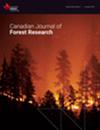Effects of forest management intensity and climate change severity on volume growth, timber yield, carbon stocks, and the amount of deadwood in Scots pine, Norway spruce and silver birch stands in boreal conditions
IF 1.7
3区 农林科学
Q2 FORESTRY
引用次数: 0
Abstract
We studied how management intensity and climate severity affect volume growth, timber yield, carbon stocks, and the amount of deadwood in Scots pine (Pinus sylvestris (L.), Norway spruce (Picea abies (L.) Karst.) and silver birch (Betula pendula Roth.) dominated stands in the Republic of Karelia and Arkhangelsk region of northwest Russia. Using the forest ecosystem model (SIMA) under different climates (current and representative concentration pathway scenarios, RCP4.5 and RCP8.5), no-thinning, low, medium, and high intensity thinning rotational forestry regimes were simulated. Under RCPs, the volume growth and timber yield (5-53%), carbon stocks (1-22%), and deadwood amounts (11-75%) increased for all Scots pine and silver birch stands. The use of low intensity management increased volume growth and carbon stocks (3-16%) and deadwood amount (up to 60%) under RCPs, but not timber yield (±3%) in these stands. For Norway spruce stands, the volume growth (5-26%), timber yield (23-75%), and carbon stocks (5-15%) decreased under RCP8.5, but deadwood amount increased (up to 142%). Intensive management increased volume growth (4-19%), timber yield (4-63%), carbon stocks (up to 14%) and deadwood amounts (up to 49%). Our results highlight that effects of climate severity and management intensity are site and species-specific for Eurasian’s boreal forests.森林管理强度和气候变化严重程度对北方条件下苏格兰松树、挪威云杉和银桦林木的体积增长、木材产量、碳储量和枯木量的影响
我们研究了俄罗斯西北部卡累利阿共和国和阿尔汉格尔斯克地区以苏格兰松(Pinus sylvestris (L.))、挪威云杉(Picea abies (L.) Karst.)和银桦(Betula pendula Roth.)为主的林分的管理强度和气候严重程度如何影响其体积增长、木材产量、碳储量和枯木量。利用森林生态系统模型(SIMA)模拟了不同气候条件(当前和代表性浓度路径情景,RCP4.5 和 RCP8.5)下的无间伐、低、中、高强度间伐轮伐林业制度。在 RCPs 条件下,所有苏格兰松树和银桦树林分的生长量和木材产量(5-53%)、碳储量(1-22%)和枯木量(11-75%)都有所增加。在 RCPs 条件下,采用低强度管理可提高这些林分的生长量、碳储量(3-16%)和枯死木量(高达 60%),但木材产量却没有提高(±3%)。对于挪威云杉林分,在 RCP8.5 条件下,体积增长率(5-26%)、木材产量(23-75%)和碳储量(5-15%)均有所下降,但枯死木量却有所增加(高达 142%)。强化管理则增加了体积增长(4-19%)、木材产量(4-63%)、碳储量(高达 14%)和枯木量(高达 49%)。我们的研究结果突出表明,气候严重程度和管理强度对欧亚北方森林的影响是因地和因物种而异的。
本文章由计算机程序翻译,如有差异,请以英文原文为准。
求助全文
约1分钟内获得全文
求助全文
来源期刊
CiteScore
4.20
自引率
9.10%
发文量
109
审稿时长
3 months
期刊介绍:
Published since 1971, the Canadian Journal of Forest Research is a monthly journal that features articles, reviews, notes and concept papers on a broad spectrum of forest sciences, including biometrics, conservation, disturbances, ecology, economics, entomology, genetics, hydrology, management, nutrient cycling, pathology, physiology, remote sensing, silviculture, social sciences, soils, stand dynamics, and wood science, all in relation to the understanding or management of ecosystem services. It also publishes special issues dedicated to a topic of current interest.

 求助内容:
求助内容: 应助结果提醒方式:
应助结果提醒方式:


